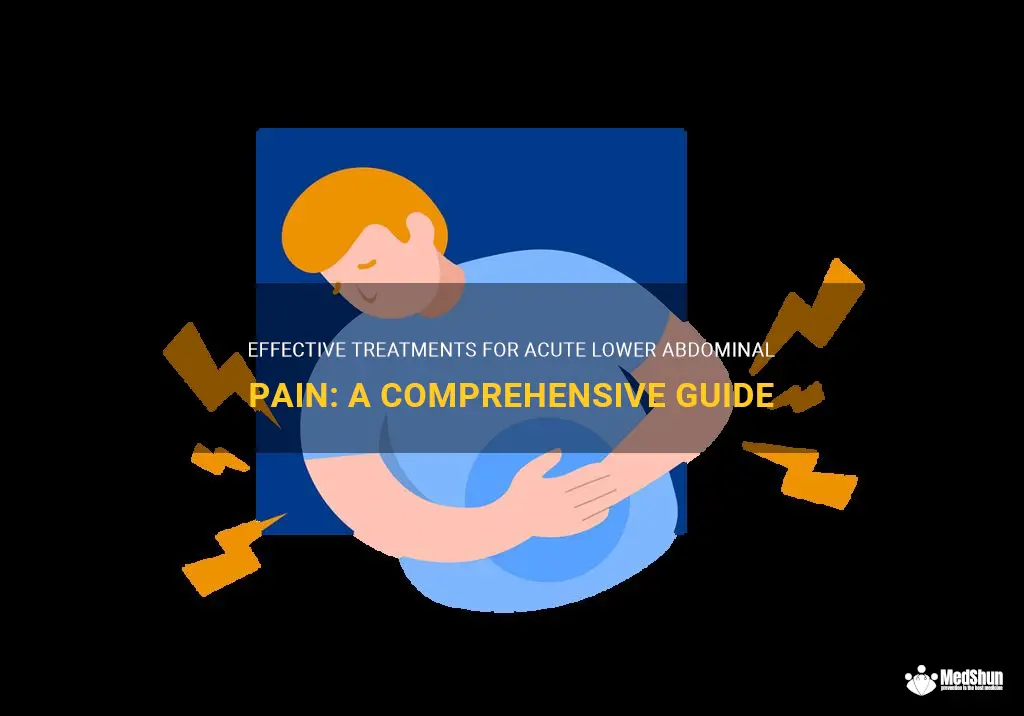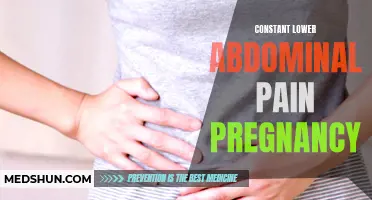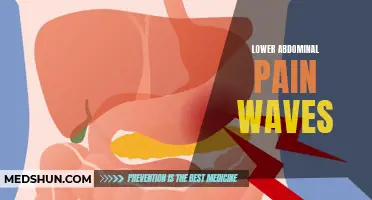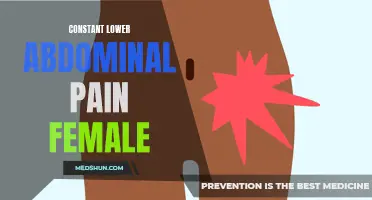
Acute lower abdominal pain can be a distressing and debilitating condition that requires immediate attention and treatment. Whether caused by a stomach infection, kidney stones, or an inflamed appendix, finding relief from the pain and addressing the underlying cause is paramount. In this article, we will explore the various treatment options available for acute lower abdominal pain, from over-the-counter pain relievers to surgical interventions, highlighting the importance of seeking professional medical guidance for an accurate diagnosis and tailored treatment plan.
| Characteristics | Values |
|---|---|
| Common Causes | Appendicitis, diverticulitis, urinary tract infection, kidney stones, pelvic inflammatory disease, ovarian cysts, ectopic pregnancy |
| Diagnostic Tests | Physical examination, blood tests, urine tests, imaging tests (CT scan, ultrasound) |
| Treatment Options | Antibiotics, pain medication, surgical removal of appendix or affected organs, lifestyle changes (diet, exercise), rest and hydration |
| Duration of Treatment | Depends on the underlying cause and severity of the condition |
| Complications | Peritonitis, sepsis, organ damage, infertility |
| Prognosis | Generally good with prompt medical intervention and appropriate treatment |
| Self-Care Measures | Resting, applying heat or cold packs, over-the-counter pain relievers, staying hydrated |
| Prevention | Maintaining a healthy diet and lifestyle, practicing safe sex, seeking prompt medical attention for abdominal pain |
What You'll Learn
- What are the common causes of acute lower abdominal pain?
- What tests or diagnostic procedures are typically performed to determine the cause of acute lower abdominal pain?
- What are the treatment options for specific causes of acute lower abdominal pain, such as appendicitis or ovarian cysts?
- Are there any home remedies or over-the-counter medications that can help alleviate acute lower abdominal pain?
- Is surgery ever required for the treatment of acute lower abdominal pain, and if so, what are the potential risks and benefits?

What are the common causes of acute lower abdominal pain?
Acute lower abdominal pain refers to a sudden and severe pain occurring in the lower part of the abdomen. This type of pain can be caused by a variety of conditions, ranging from benign and self-limiting to more serious and life-threatening. Understanding the common causes of acute lower abdominal pain is essential for proper diagnosis and treatment.
One of the most common causes of acute lower abdominal pain is acute appendicitis. The appendix is a small, finger-like pouch located in the lower right side of the abdomen. When it becomes inflamed or infected, it can cause intense pain. Other symptoms of appendicitis may include fever, nausea, vomiting, and loss of appetite. Appendicitis requires immediate medical attention, as it can lead to a ruptured appendix, which is a medical emergency.
Another common cause of acute lower abdominal pain is gastrointestinal issues such as gastroenteritis or bowel obstruction. Gastroenteritis, also known as the stomach flu, is an inflammation of the stomach and intestines caused by a viral or bacterial infection. Symptoms may include diarrhea, vomiting, abdominal cramps, and fever. Bowel obstruction occurs when there is a blockage in the bowel, which can be caused by tumors, scar tissue, or hernias. This condition typically presents with severe abdominal pain, bloating, constipation, and inability to pass gas or have a bowel movement.
Renal colic, which refers to the severe pain caused by the passage of a kidney stone, can also result in acute lower abdominal pain. Kidney stones are hard deposits that form in the kidneys and can become lodged in the urinary tract. Besides lower abdominal pain, renal colic may cause back pain, blood in the urine, and frequent urination. Treatment for kidney stones may involve pain medication, hydration, and in some cases, surgical intervention.
Gynecological conditions can also lead to acute lower abdominal pain. Conditions such as ovarian cysts, ectopic pregnancy, or pelvic inflammatory disease can cause sudden and severe pain in the lower abdomen. Ovarian cysts are fluid-filled sacs that develop on or within the ovaries, while an ectopic pregnancy occurs when a fertilized egg implants outside the uterus, usually in the fallopian tube. Pelvic inflammatory disease is an infection of the female reproductive organs, usually caused by sexually transmitted bacteria. These conditions require medical evaluation and treatment, as they can result in complications if left untreated.
Other less common causes of acute lower abdominal pain include urinary tract infections, diverticulitis, and hernias. Urinary tract infections occur when bacteria enter the urinary tract and can cause pain in the lower abdomen, along with urinary symptoms such as frequent urination or burning sensation. Diverticulitis is an inflammation or infection of the small pouches that can form in the colon, called diverticula. Symptoms may include abdominal pain, fever, and changes in bowel habits. Hernias can also cause acute lower abdominal pain if a portion of an organ or tissue protrudes through a weak spot in the abdominal wall. These conditions may require specific treatment approaches depending on the severity and underlying cause.
In conclusion, acute lower abdominal pain can have various causes, ranging from relatively benign conditions to serious medical emergencies. Prompt evaluation and diagnosis by a healthcare professional are crucial for appropriate management. If you experience sudden and severe lower abdominal pain, it is important to seek immediate medical attention to determine the cause and receive appropriate treatment.
Mild right lower abdominal pain: causes, symptoms, and treatment
You may want to see also

What tests or diagnostic procedures are typically performed to determine the cause of acute lower abdominal pain?
Acute lower abdominal pain is a common symptom that can have a wide range of causes. To determine the underlying cause of the pain, healthcare providers typically perform a series of tests and diagnostic procedures. These tests aim to identify the specific condition or disease that is leading to the abdominal pain and guide appropriate treatment.
One of the first steps in diagnosing acute lower abdominal pain is a thorough medical history and physical examination. The healthcare provider will ask about the location, duration, and nature of the pain, as well as any accompanying symptoms. They will also evaluate the patient's medical history, including any previous surgeries, illnesses, or conditions that may be relevant to the current symptoms.
After gathering this initial information, the healthcare provider may order further tests to help narrow down the possible causes of the pain. These tests may include:
- Blood tests: Blood tests can provide valuable information about the overall health of the patient and can indicate the presence of any infections or inflammatory markers. For example, an elevated white blood cell count may suggest an infection, while an increased level of certain enzymes may indicate organ damage or inflammation.
- Urine tests: Urine tests can help detect the presence of urinary tract infections or kidney stones, which can cause lower abdominal pain. Additionally, urine tests can also check for signs of blood or other abnormalities that may point to underlying conditions.
- Imaging studies: Various imaging techniques can provide detailed images of the abdomen and help identify any structural abnormalities. The most commonly used imaging tests for lower abdominal pain include:
- Ultrasound: Ultrasound uses sound waves to create images of the internal organs, allowing the healthcare provider to look for abnormalities in the abdomen, such as gallstones, ovarian cysts, or appendicitis.
- X-ray: X-rays can be useful in diagnosing conditions such as urinary stones or intestinal blockages. However, they are less commonly used than other imaging techniques.
- CT scan: A computed tomography (CT) scan provides detailed cross-sectional images of the abdomen, making it highly useful in identifying conditions like appendicitis, diverticulitis, or tumors.
- MRI: Magnetic resonance imaging (MRI) uses powerful magnets and radio waves to create detailed images of the abdomen. It is particularly helpful in evaluating pelvic disorders and soft tissue abnormalities.
- Endoscopy: In certain cases, an endoscopy may be performed to visualize the digestive tract directly. This procedure involves inserting a flexible tube with a light and camera into the mouth or anus, allowing the healthcare provider to examine the esophagus, stomach, or colon for any abnormalities, such as ulcers, inflammation, or tumors.
- Laparoscopy: Laparoscopy is a surgical procedure that involves making small incisions in the abdomen and inserting a camera and other instruments to visualize the internal organs. This technique allows for a direct examination and potential treatment of conditions such as appendicitis or endometriosis.
The specific tests and diagnostic procedures performed will depend on the suspected underlying cause of the abdominal pain. It is essential to consult with a healthcare provider to determine the most appropriate diagnostic approach for each individual case.
In conclusion, determining the cause of acute lower abdominal pain often requires a combination of tests and diagnostic procedures. These may include blood and urine tests, imaging studies such as ultrasound, CT scan, or MRI, as well as endoscopy or laparoscopy. The results of these tests can help healthcare providers identify the specific condition or disease causing the abdominal pain and guide appropriate treatment.
Sharp Lower Back and Abdominal Pain: Causes and Treatments
You may want to see also

What are the treatment options for specific causes of acute lower abdominal pain, such as appendicitis or ovarian cysts?
Acute lower abdominal pain can have a variety of causes, including appendicitis and ovarian cysts. These conditions require different treatment approaches, and it is essential to identify the specific cause of the pain before initiating any treatment. In this article, we will discuss the treatment options for appendicitis and ovarian cysts in detail.
Appendicitis is a condition characterized by inflammation of the appendix, a small organ located in the lower right abdomen. If left untreated, appendicitis can lead to serious complications, such as a ruptured appendix. The treatment for appendicitis typically involves surgical removal of the inflamed appendix, a procedure known as an appendectomy. This can be done using either an open or laparoscopic approach.
An open appendectomy involves making a small incision in the lower right abdomen and removing the appendix. This procedure is generally performed under general anesthesia. Open appendectomy may be preferred in certain cases, such as when the appendix is ruptured or when there is significant inflammation in the surrounding tissues.
On the other hand, a laparoscopic appendectomy is a minimally invasive procedure that uses small incisions and a camera to remove the appendix. This approach offers several advantages, including smaller incisions, less pain, and faster recovery times. Laparoscopic appendectomy is often the preferred method for uncomplicated appendicitis.
After the appendectomy, patients may be prescribed antibiotics to prevent infection and manage post-operative pain. Most individuals recover fully within a few weeks following surgery.
Ovarian cysts, on the other hand, are fluid-filled sacs that develop on the ovaries. They are a common gynecological problem that can cause lower abdominal pain. The treatment for ovarian cysts depends on several factors, including the size of the cyst, the symptoms experienced, and the woman's reproductive plans.
If an ovarian cyst is small and not causing any symptoms, a watchful waiting approach may be adopted. In this case, the cyst will be closely monitored through regular ultrasound scans to ensure it resolves on its own. Pain medication may be prescribed to alleviate any discomfort.
If an ovarian cyst is larger or causing severe symptoms, treatment options may include hormonal therapy or surgery. Hormonal therapy involves the use of birth control pills or other hormone medications to regulate the menstrual cycle and prevent the formation of new cysts. This approach can help shrink existing cysts and prevent new ones from forming.
Surgery may be recommended if the cyst is large, persists for several months, or causes severe pain. The surgical procedure, known as an ovarian cystectomy, involves removing the cyst while preserving the unaffected ovarian tissue. In some cases, if the cyst is cancerous or there are concerns about ovarian cancer, a total hysterectomy (removal of the uterus and ovaries) may be performed.
It is important to note that the treatment options for acute lower abdominal pain may vary depending on individual circumstances. It is essential to consult a healthcare professional for a proper diagnosis and personalized treatment plan.
In conclusion, the treatment options for specific causes of acute lower abdominal pain, such as appendicitis and ovarian cysts, differ significantly. Appendicitis typically requires surgical removal of the inflamed appendix, while ovarian cysts may be managed through watchful waiting, hormonal therapy, or surgical intervention. It is crucial to seek medical attention for an accurate diagnosis and appropriate treatment.
Chest and Lower Abdominal Pain: A Troubling Combination
You may want to see also

Are there any home remedies or over-the-counter medications that can help alleviate acute lower abdominal pain?
Acute lower abdominal pain can be caused by a variety of factors, including gastrointestinal issues, urinary tract infections, appendicitis, and pelvic inflammatory disease, among others. While it is always advisable to seek medical attention for severe or persistent abdominal pain, there are a few home remedies and over-the-counter medications that may help alleviate mild cases of abdominal pain. It is important to note that these remedies may only provide temporary relief and should not replace medical intervention if the pain persists or worsens.
Heat Therapy:
Applying a heating pad or hot water bottle to the lower abdominal area can help relax the muscles and relieve pain. Heat therapy can improve blood flow, reduce inflammation, and ease muscle spasms. Remember to use a cloth or towel as a barrier to protect your skin from direct heat.
Over-the-Counter Pain Relievers:
Over-the-counter nonsteroidal anti-inflammatory drugs (NSAIDs), such as ibuprofen or naproxen, can help reduce inflammation and alleviate pain. Follow the recommended dosage and precautions on the packaging and consult a healthcare professional if you have any underlying conditions or are taking other medications.
Peppermint Tea:
Peppermint has been used for centuries to relieve digestive discomfort, including abdominal pain. Peppermint tea can help relax the gastrointestinal muscles, reducing spasms and relieving bloating. However, individuals with gastroesophageal reflux disease (GERD) or acid reflux may want to avoid peppermint, as it can worsen their symptoms.
Ginger:
Ginger has natural anti-inflammatory and pain-relieving properties. It can help soothe an upset stomach, reduce bloating, and alleviate abdominal pain. Ginger can be consumed as ginger tea, added to meals, or taken in the form of ginger capsules or supplements. It is always advisable to consult a healthcare professional before starting any new supplements.
Probiotics:
Probiotics are beneficial bacteria that can help improve gut health and alleviate digestive issues. They can help restore the natural balance of gut bacteria and reduce symptoms like abdominal pain, bloating, and gas. Probiotics are available as supplements or in certain foods, such as yogurt and fermented foods. Choose a probiotic strain that is suitable for your specific condition and follow the recommended dosage.
Hydration and Dietary Changes:
Drinking plenty of water and staying hydrated can help prevent constipation and relieve abdominal pain. Increasing fiber intake through fruits, vegetables, and whole grains can also aid digestion and promote bowel regularity. Avoiding foods that are known to trigger abdominal pain, such as spicy or fatty foods, may also provide relief.
It is important to remember that these home remedies and over-the-counter medications are not a long-term solution for chronic or severe lower abdominal pain. If the pain persists, worsens, or is accompanied by other concerning symptoms, it is crucial to seek medical attention promptly. A healthcare professional will be able to diagnose the underlying cause of the pain and provide appropriate treatment.
Understanding the Causes of Left-Sided Male Abdominal Pain
You may want to see also

Is surgery ever required for the treatment of acute lower abdominal pain, and if so, what are the potential risks and benefits?
Acute lower abdominal pain can be a symptom of various conditions, ranging from mild and self-limiting to severe and life-threatening. While many cases can be successfully managed with conservative measures, there are certain situations in which surgery may be required for the treatment of this condition. In this article, we will explore when surgery may be necessary, as well as the potential risks and benefits associated with surgical intervention in acute lower abdominal pain.
One of the most common causes of acute lower abdominal pain requiring surgical intervention is appendicitis. The appendix is a small organ located in the right lower abdomen, and inflammation of this organ can cause significant pain and discomfort. While not all cases of appendicitis require surgery, the presence of certain symptoms, such as increasing pain, fever, and the inability to tolerate oral fluids, may indicate a need for surgical removal of the appendix. This procedure, known as an appendectomy, can be performed either traditionally through an open incision or using minimally invasive techniques, such as laparoscopy. The benefits of surgical treatment for appendicitis include the elimination of pain and the prevention of potentially life-threatening complications, such as a ruptured appendix.
Another condition that may require surgical intervention for acute lower abdominal pain is ovarian torsion. This occurs when the ovary twists upon itself, leading to a disruption in blood flow and intense pain. Surgery is often necessary to untwist the ovary and restore blood supply. Similar to appendicitis, ovarian torsion can be managed with either open surgery or laparoscopy, depending on the severity of the condition and the expertise of the surgeon. The main benefit of surgical treatment for ovarian torsion is the relief of pain and the preservation of ovarian function.
In some cases, acute lower abdominal pain may be an indication of a more serious underlying condition, such as a bowel obstruction or perforation. These conditions are typically associated with severe pain, fever, vomiting, and an inability to pass gas or bowel movements. Surgery is often required to correct the underlying problem, remove the obstruction or repair the perforation, and prevent complications such as infection and sepsis.
While surgery can be lifesaving in certain cases of acute lower abdominal pain, it is not without risks. Like any surgical procedure, there is always a risk of complications, such as bleeding, infection, and damage to adjacent organs. In addition, surgery may sometimes be associated with a longer recovery time and post-operative pain. However, the potential benefits of surgical intervention in acute lower abdominal pain often outweigh the risks, especially when the condition is severe or life-threatening.
It is important to note that not all cases of acute lower abdominal pain require surgical intervention. Many conditions can be managed conservatively with rest, pain medication, and other supportive measures. However, it is crucial to seek medical attention if you experience severe abdominal pain that does not improve or worsens over time, especially if it is accompanied by other concerning symptoms such as fever, vomiting, or difficulty eating or drinking.
In conclusion, surgery may be necessary for the treatment of acute lower abdominal pain in certain situations, such as appendicitis, ovarian torsion, or bowel obstruction. The potential benefits of surgical intervention include pain relief and the prevention of complications. However, surgery is not without risks, and each case should be carefully evaluated by a healthcare professional to determine the most appropriate course of treatment. If you are experiencing acute lower abdominal pain, it is essential to seek medical attention promptly to ensure timely and appropriate management of your condition.
ICD-10 Code for Right Lower Abdominal Pain
You may want to see also
Frequently asked questions
- The treatment for acute lower abdominal pain depends on the underlying cause. However, some common treatment options may include pain medication, rest and relaxation, hot or cold compresses, and lifestyle modifications such as changes in diet or exercise.
- Over-the-counter pain relievers such as ibuprofen or acetaminophen may provide temporary relief for mild cases of acute lower abdominal pain. However, it is important to consult a healthcare professional for a proper diagnosis and to discuss the appropriate pain management options.
- It is advisable to seek medical attention for acute lower abdominal pain if the pain is severe, persistent, or accompanied by other symptoms such as fever, vomiting, blood in the stool, or difficulty urinating. Prompt medical evaluation is also necessary if the pain is sudden and severe or if it worsens over time.
- While home remedies or lifestyle changes may provide relief for mild cases of acute lower abdominal pain, it is crucial to consult a healthcare professional for a proper diagnosis and guidance. Some potential home remedies or lifestyle changes that may help include drinking plenty of fluids, avoiding foods that may irritate the stomach or intestines, practicing stress-reducing techniques, and engaging in regular exercise.








3 Comments
Aubrie Ramsey
Maliyah Guerrero
Anna Werrett
Author